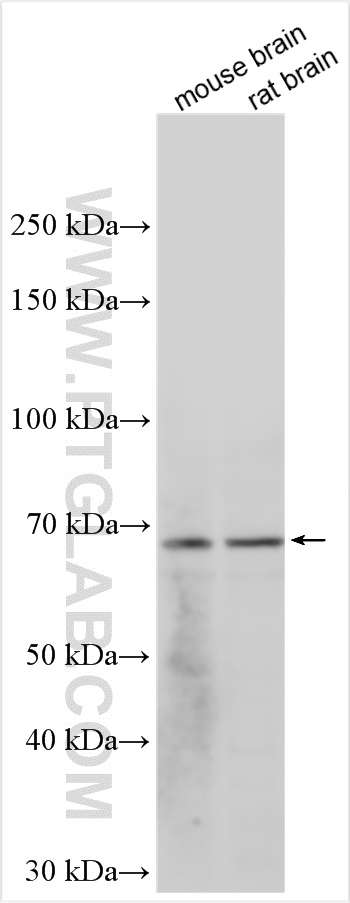验证数据展示
经过测试的应用
| Positive WB detected in | unboiled mouse brain tissue, unboiled rat brain tissue |
推荐稀释比
| 应用 | 推荐稀释比 |
|---|---|
| Western Blot (WB) | WB : 1:500-1:1000 |
| It is recommended that this reagent should be titrated in each testing system to obtain optimal results. | |
| Sample-dependent, Check data in validation data gallery. | |
产品信息
27594-1-AP targets Glypican 2 in WB, ELISA applications and shows reactivity with mouse, rat samples.
| 经测试应用 | WB, ELISA Application Description |
| 经测试反应性 | mouse, rat |
| 免疫原 | Glypican 2 fusion protein Ag26734 种属同源性预测 |
| 宿主/亚型 | Rabbit / IgG |
| 抗体类别 | Polyclonal |
| 产品类型 | Antibody |
| 全称 | glypican 2 |
| 别名 | GPC2, Secreted glypican-2, FLJ38962 |
| 计算分子量 | 579 aa, 63 kDa |
| 观测分子量 | 62-67 kDa |
| GenBank蛋白编号 | BC027972 |
| 基因名称 | GPC2 |
| Gene ID (NCBI) | 221914 |
| RRID | AB_3085972 |
| 偶联类型 | Unconjugated |
| 形式 | Liquid |
| 纯化方式 | Antigen affinity purification |
| UNIPROT ID | Q8N158 |
| 储存缓冲液 | PBS with 0.02% sodium azide and 50% glycerol , pH 7.3 |
| 储存条件 | Store at -20°C. Stable for one year after shipment. Aliquoting is unnecessary for -20oC storage. |
背景介绍
GPC2 (glypican 2), which is expected to be located in cell membrane and extracellular space. It is expressed in lymphoid tissue, skin and testis. The calculated molecular weight of the protein is 62 kDa. GPC2 is mainly active in growing nervous tissues and thyroid cancer tissues (PMID: 28616017). It participates in the growth and differentiation of neuronal axons. Increasing evidence has demonstrated the overexpression of GPC2 in neuroblastoma, a kind of childhood cancer. There is a discovery that GPC2 can be employed as a diagnostic, prognostic, and immunological predictor of generalized cancers. The study may broaden the train of thought toward application of GPC2 in immunotherapy (PMID: 35345673).
实验方案
| Product Specific Protocols | |
|---|---|
| WB protocol for Glypican 2 antibody 27594-1-AP | Download protocol |
| Standard Protocols | |
|---|---|
| Click here to view our Standard Protocols |
